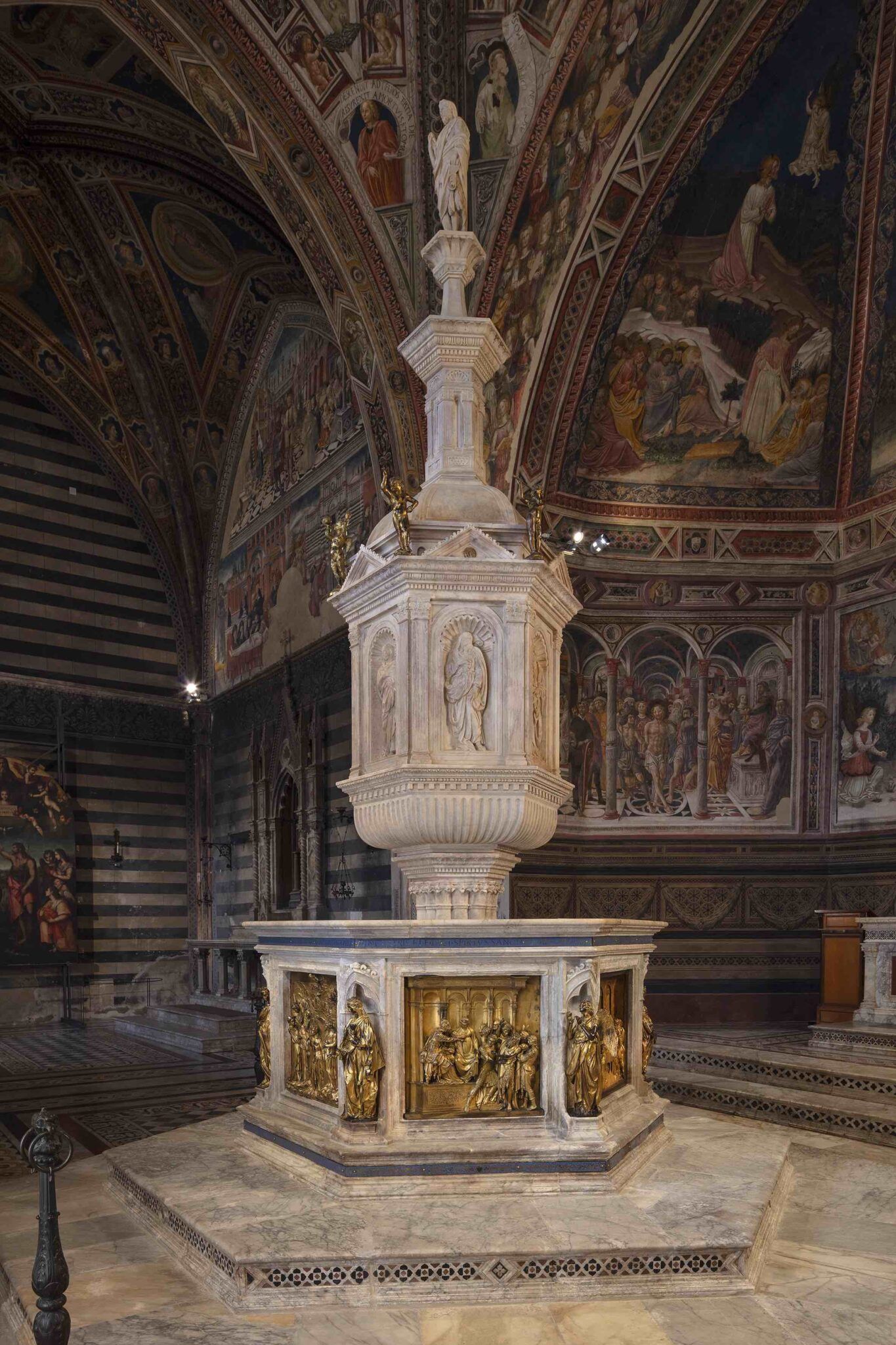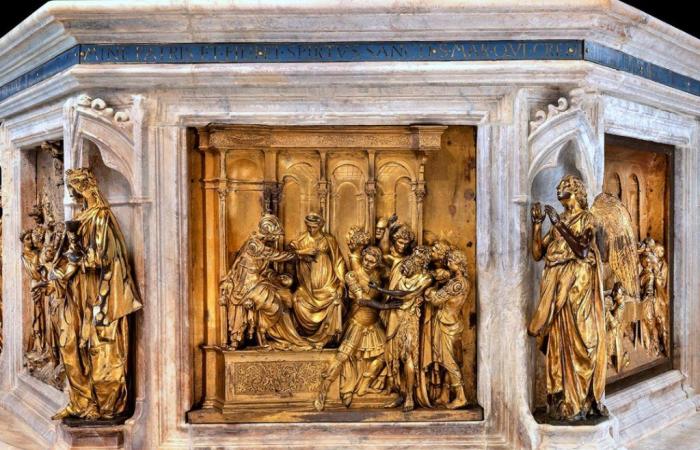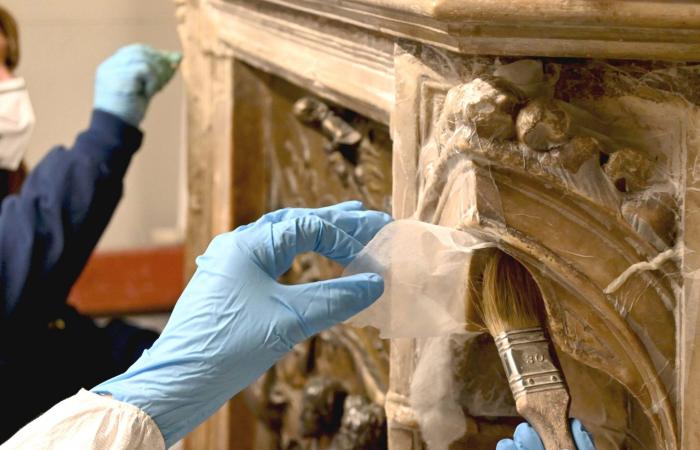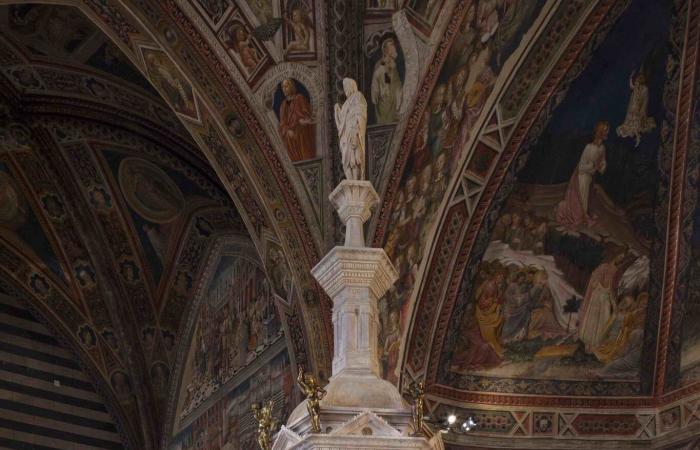From 25 June 2024 it finally becomes visible again afterwards three years of restoration and conservative interventions Baptismal font of the Cathedral of Siena.
Thanks to the joint work ofSiena Metro Opera and of theArchdiocese of Siena, Colle di Val d’Elsa and Montalcinoit will be possible to return to admire the extraordinary sculptural installation created by Donatello, Jacopo della Quercia, Ghiberti and Giovanni di Turino.
The restoration is the result of a series of interventions, of the highest and innovative technical level, conducted by the staff of the Opera and the highly specialized staff of theHard Stone Factory of Florenceled first by the late Marco Ciatti and, subsequently from Emanuela Daffra.
“For a Christian, new life is born with baptism – underlines the Cardinal Augusto Paolo Lojudice, archbishop of Siena, Colle di Val d’Elsa, Montalcino – and the baptismal font of the Siena cathedral has seen many generations of famous and less famous Sienese, many ordinary people, all inextricably linked to this unique city, ‘born to new life’. Today, the strong spiritual and religious connotation is added to the suggestion for the restitution to the world of an absolute masterpiece of the Italian Renaissance”.
Work team during the completion of the restoration of Donatello’s Banquet of Herod
The restoration of the baptismal font of the Siena Cathedral
The restoration work is the result of a synergy between the Fabbriceria, the Superintendency of Archaeology, Fine Arts and Landscape for the provinces of Siena, Grosseto and Arezzo el‘Opificio delle Pietre Dure of Florence, who was entrusted with the direction of the restoration, coordinated by art historians Laura Speranza and Riccardo Gennaioli, respectively directors of Bronze Restoration and Stone Materials sectors of the OPD.
The stone restoration was carried out by the restorer Andrea Galgani and by collaborators Serena Bianchi and Lucrezia Coletta who, on a daily basis, together with the external restorer Irene Giovacchini, carried out consolidation and cleaning interventions following the indications and methodological choices developed by the technical and scientific management.
In the OPD laboratories in Florence they worked on the metal parts, with the technical direction of Stefania Agnoletti, the internal restorers Maria Baruffetti, Annalena Brini, Elisa Pucci of the Bronzes sector directed by Laura Speranza. External restorers were also involved (Antonio Mignemi, Stefano Casu, Elena della Schiava and Merj Nesi).
The technical area of the Opera del Duomo directed byarchitect Enrico De Benedetti he also designed and curated the new layout of the Baptistery aimed at improving reception and use.
“Dealing with such a complex and significant work for the history of art is always difficult – he has declared Emanuela Daffra, Superintendent of the OPD – In this case the difficulties were, and are, increased by other factors: on the one hand the use value of the Fonte, born as an ‘instrument’ for the administration of a sacrament, which this function still maintains today. On the other hand, environmental conditions are not ideal for conservation, especially of bronzes. The OPD staff has taken up the challenge of maintaining both the completeness and the original destination of the monument for now, but it is precisely from this that the program of six-monthly inspections and the invitation to monitor and scrupulously control environmental parameters was born. Only constant attention will allow us to promptly detect signs of deterioration and immediately identify the most suitable measures.”
To check the condition of the architectural structure and environmental parameters have been undertaken two different investigation campaigns in situ: ultrasonic measurements they verified the presence of metal anchors inside the Fonte e geophysical investigations on the floor they investigated the presence of voids or humidity fronts in the archaeological substratum.
They were later dismantled the bronze elements to evaluate the state of conservation of non-visible surfaces and intervene on areas that otherwise would not have been accessible.
The careful study ofDonatello’s panel with “Herod’s Banquet” allowed us to identify the presence, in the past, of tie rods applied between the arches above the scene which had to amplify the perspective and realistic effect of the architecture depicted which offers three different spaces in succession.
The stone elements were restored on site in the construction site set up inside the Baptistery. If disassembly wasn’t easy even the reassembly proved no less, since it resulted the study and creation of new fastening elements and joints made ad hoc in order to readjust the positions of the incorrect architectural stone elements.
A complex and long job which made scholars understand that they will be necessary in the future environmental monitoring and the adoption of humidity control systems aimed at ensuring the best conservation of this masterpiece.
The cleaning phase of the marble part with solvents
The Baptismal Font of the Siena Cathedral: a Renaissance masterpiece
The baptismal fontlocated in the center of the Baptistery, is one of the major masterpieces preserved within the monumental complex of the Siena Cathedral.
This extraordinary work in marble, bronze and enamelled copper was accomplished between 1417 and 1431 by the most important sculptors of the early Renaissance.
The Source consists of a hexagonal tub in which i are inserted six mirrors in gilded bronze depicting the life of the Baptist, marked by the statues of virtue of which two, Faith and Hope, made by Donatello.
Among the most representative episodes is the Baptism of Jesus Of Lorenzo Ghiberti of 1427, the cycle ends with the famous Herod’s Banquet Of Donatellothe most touching scene for the drama of the subject and the quality.
To build the Fonte were used different marbles, enriched by blue and gold polychrome details, and gilded bronzes. The architectural structure is entirely made in White marble of two different qualities: for the lower register a veined variety coming from the Sienese Montagnola, for the tabernacle and the figure of the Baptist a second more homogeneous one coming from the Apuan area.
It is possible to visit the Baptistery every day from 10am to 7pm. Info and reservations: [email protected] – +39 0577 286300.
The visit to the Baptistery includes entrance to the Cathedral, the Piccolomini Bookshop, the Opera Museum, the Panorama from the Facade and the Crypt.

Baptismal font after restoration photo by Bruno Bruchi








